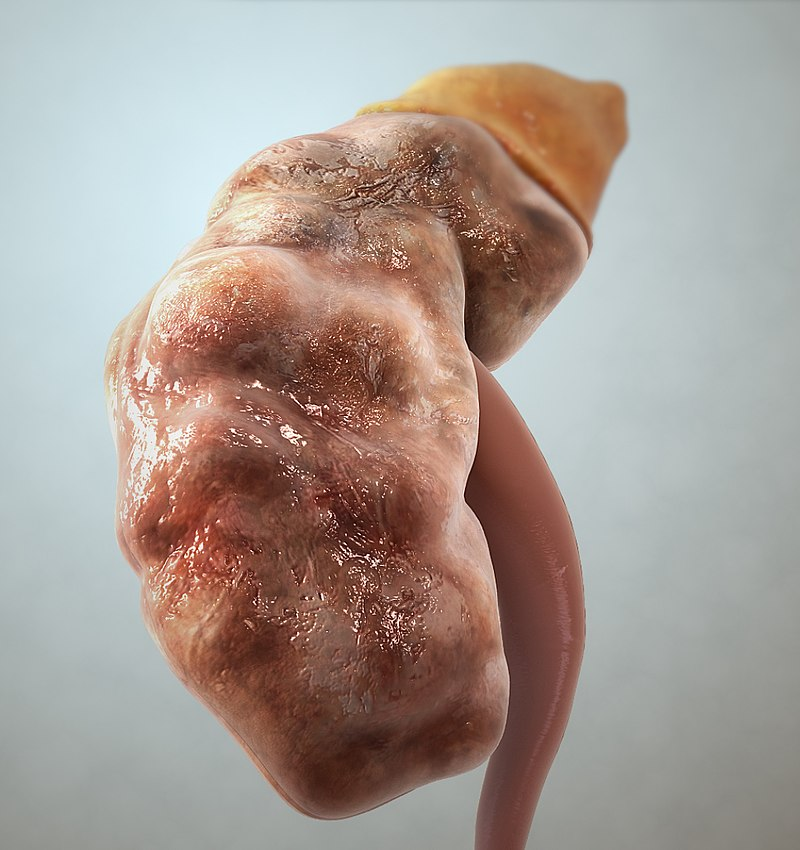After seeing a few patients with chronic kidney failure, I decided to write a post on chronic kidney disease. I hope after reading this post you learn a lot about chronic kidney disease and how to prevent it.
Quick facts about chronic kidney disease
- It has no cure and it is not irreversible. Survival is dependent on either a transplant or dialysis.
- The global estimated prevalence of chronic kidney disease is 13.4% (11.7-15.1%), and patients with end-stage kidney disease (ESKD) needing renal replacement therapy are estimated between 4.902 and 7.083 million. This means that for every 100 persons that you see 13 out of them have chronic kidney disease.
- The commonest causes of chronic kidney disease are hypertension and diabetes. So prevention should be aimed at lifestyle modification primarily against hypertension and diabetes.

By scientificanimations, CC BY-SA 4.0, Wikimedia
What is chronic kidney disease?
Chronic kidney disease is a kidney disease lasting for three or more resulting from progressive loss of nephron mass. It is usually characterized by damage in either the structure or function of the kidney lasting for more than three months. This means that the essential building blocks of the kidney gets destroyed and so the kidney cannot function optimally.
Some Anatomy of the kidney
For you to understand the concept of chronic kidney disease, an understanding of the structure of the kidney is essential.
The kidneys are located at the lower back around the flank region. Every human being has two kidneys but can function with one when the first gets damaged.
The kidney is made up of tiny units called the nephrons. The nephron is the functional unit of the kidney. A healthy adult kidney has about 1.5 million nephrons in each kidney. These nephrons are the units that collectively work in order for one to say the kidneys are in shape.
Healthy nephrons are capable of taking some extra work in the presence of dying ones but with progressive damage of more nephrons, the nephrons left are unable to carry out the functions of the kidney. They become overwhelmed by the work and this then results in kidney damage. When this occurs for more than 3 months, the condition is known as CKD.
Just picture a company that had initially 15 workers and they were capable of doing their duties when a person leaves they might be able to still do the work but when 50% of them leave they won't be able to do the job effectively. Now if 70% of the people leave the job, the 30% left won't be able to make up for it and the firm may crash. This is what CKD feels like.
What are the functions of the kidney?
The kidney is a very vital organ and it is said to be amongst the vital organs in the body alongside the brain and heart.
The kidney helps to maintain overall fluid balance by excreting excess fluid or absorbing fluids when deficient. This helps to prevent dehydration and fluid overload. Another function that most of us know is the fact that the kidney helps in the excretion of waste like urea from the blood.
It is also interesting to note that the kidney also has endocrine functions as it is capable of secreting hormones. The kidney secretes erythropoietin that helps with creating new red blood cells.
In my post, on hypertension, I also mentioned the role of kidneys in regulating blood pressure by secreting renin from the juxtaglomerular apparatus.
The kidney also secretes hormones that help with bone growth.
When the kidney is diseased, there will be a total or partial loss of the above functions. When a patient has end-stage kidney disease there will be a total loss of function.
With this brief anatomy and physiology, we can move to the causes of chronic kidney disease.
What are the causes of Chronic Kidney disease?
Like I earlier said, the most common causes of chronic kidney disease are hypertension and diabetes mellitus. This is because these conditions are progressive and long-lasting. This is why hypertension and diabetes have to be monitored closely as one gets older.
Adult polycystic kidney is a genetic condition in which cysts(fluid-filled cavities) form within the kidneys. These cysts interfere with the functions of the kidney by disrupting the structure and hereby cause the kidney to damage.
Infection primarily affecting the kidney is called pyelonephritis. Long-standing pyelonephritis has been implicated as a cause of CKD.
Urinary tract infection has also been observed to cause chronic kidney disease due to the fact that the infection can trackback to the kidneys and cause pyelonephritis.
Glomerulonephritis is another cause of chronic kidney disease. The glomeruli are extremely small structures inside the kidneys that filter the blood. Glomerulonephritis refers to inflammation of the glomerulus and can be caused by various things. Infections, drugs are a few causes of glomerulonephritis.
There are more causes of CKD but these are a few common causes.
How can you identify someone with chronic kidney disease?

By Nephrotic syndrome, CC BY-SA 3.0, Wikimedia
CKD has various forms in which it presents, it can be easy to identify sometimes, other times it might be difficult to ascertain the cause hence, necessitating laboratory tests to confirm the diagnosis and trace a cause.
I remember a woman who was diabetic, with poorly controlled blood pressure. She came complaining of her face been swollen in the morning but gets better as the day goes by. This is one of the few symptoms that is classic of kidney diseases. Since the kidney helps to remove excess fluid in the body, when the kidneys are bad, excretion is impaired and there is a reduction in urinary output and there is an accumulation of fluid.
Some people can present with irrational talks which can be confused with a psychiatric condition. This is most times due to the accumulation of electrolytes like urea in the body that is meant to be excreted.
I remember talking about a patient who I lost who had CKD due to diabetes. She presented with breathlessness and abdominal distension due to the accumulation of fluid in the lungs and abdomen. Kidney diseases can present this way too.
Other symptoms include;
- Getting easily tired that can be confused with the easy fatiguability that comes with heart failure.
- swelling of your legs, ankles, and feet from retention of fluids caused by the failure of the kidneys to eliminate water waste
- There can be persistent nausea, confusion, pain or pressure in your chest, seizures, coma. This set of symptoms are due to the accumulation of urea and this happens when the damage is way too advanced.
What are the early signs of chronic kidney disease?
Early diagnosis and treatment of CKD can help with the outcome in terms of survival and quality of life.
The earliest sign of kidney disease is a reduction in urinary output despite adequate intake. Then if you also discover that you pass very little concentrated urine you should have your kidneys checked.
Signs of fluid retention are another early way to suspect kidney disease. Signs of fluid retention include; abdominal distension, swelling of the ankle, and sometimes breathlessness.
How can kidney disease be prevented?
This is the most important part of this post as preventing this disease is better than going through the problem of curing it.
As with most of my posts, prevention starts with health education about chronic kidney disease. Education plays a huge role in reducing the incidence of a disease like CKD.
Educating people about things that increase their risk will also go a long way.
Other ways of preventing CKD include
-
Preventing the most common causes like diabetes and hypertension. Ways of preventing these chronic conditions include
- Diet modification: A healthy diet will help prevent conditions like diabetes, atherosclerosis, and some heart conditions which can cause kidney failure. Diets high in fats and refined sugars can predispose one to diabetes and myocardial infarction which in turn can lead to kidney failure.
- Proper management of these conditions: Proper management involves adherence to drugs, lifestyle modification, and regular visits to the physician before the problem escalates.
-
Studies have shown that some substances have been implicated in the etiology of CKD. These substances include; excessive alcohol, drugs like gentamycin, aspirin, and NSAIDs. These substances should be avoided or used with caution.
-
Adequate intake of water: Taking enough water helps the kidney to function properly. Kidney stones can cause CKD, drinking at least 3Liters of water a day can prevent stones from developing and hence prevent CKD.
In my next post, I will be talking about treatment options and complications of chronic kidney disease.
Reference
- Lv JC, Zhang LX. Prevalence and Disease Burden of Chronic Kidney Disease. Adv Exp Med Biol. 2019;1165:3-15. DOI: 10.1007/978-981-13-8871-2_1. PMID: 31399958.
- NIDDK
- Medical news today
- Health line
Originally posted here: https://hive.blog/hive-196387/@bhoa/when-the-kidney-shuts-down-a-case-of-chronic-kidney-disease
No comments:
Post a Comment